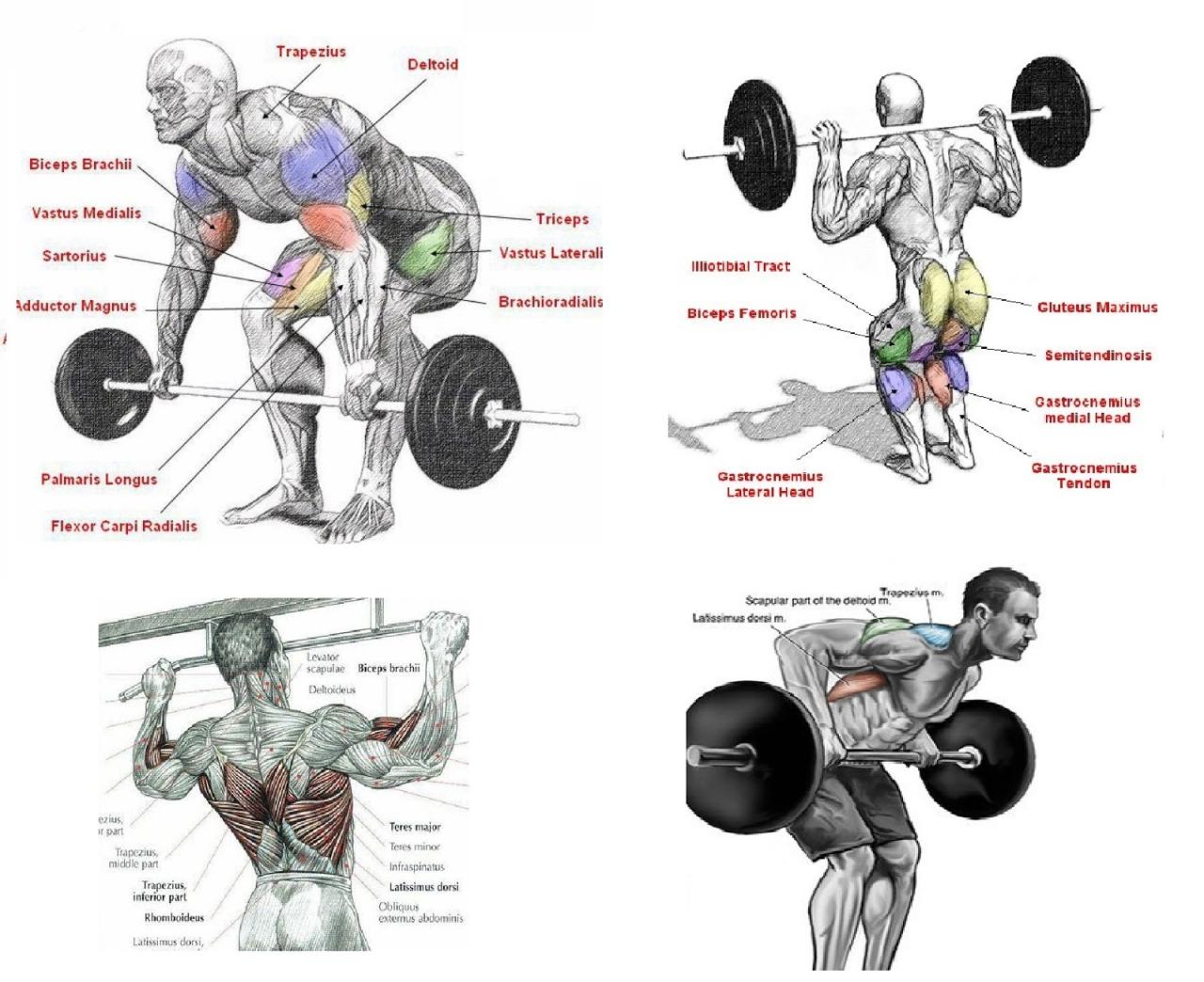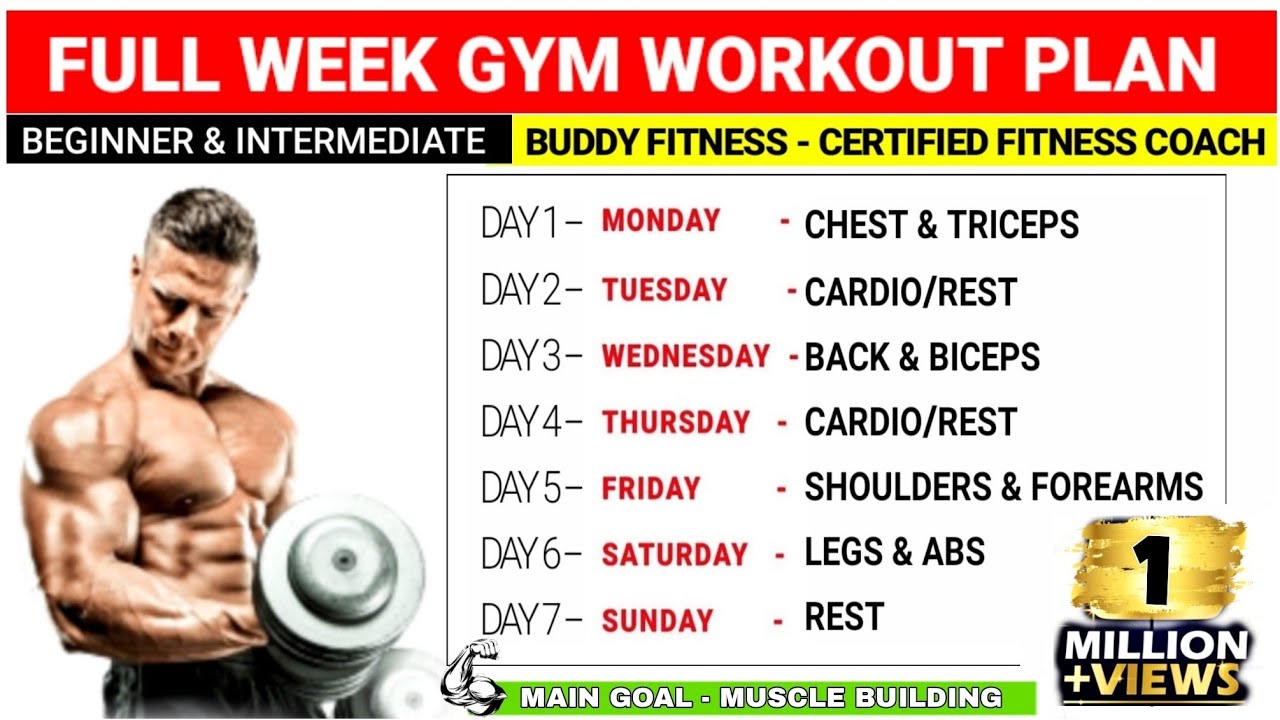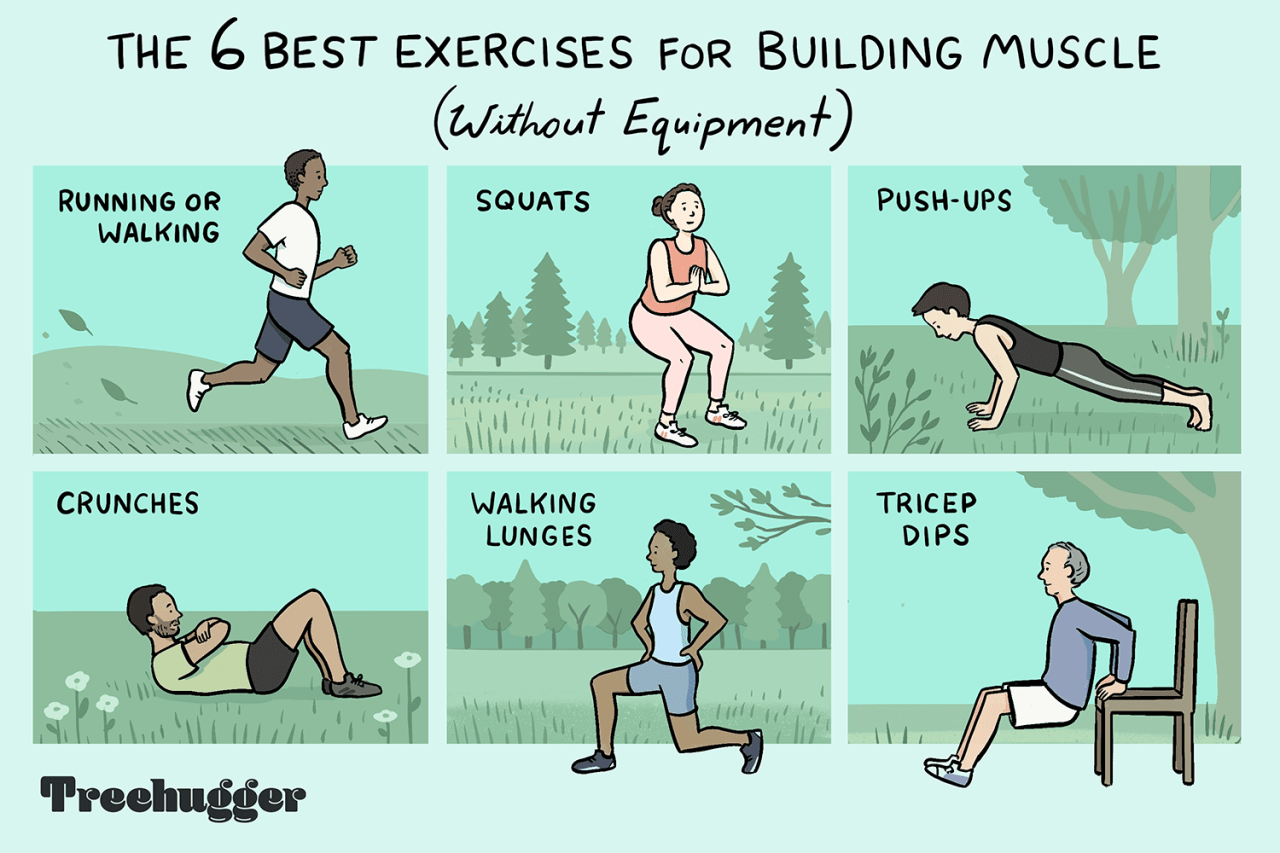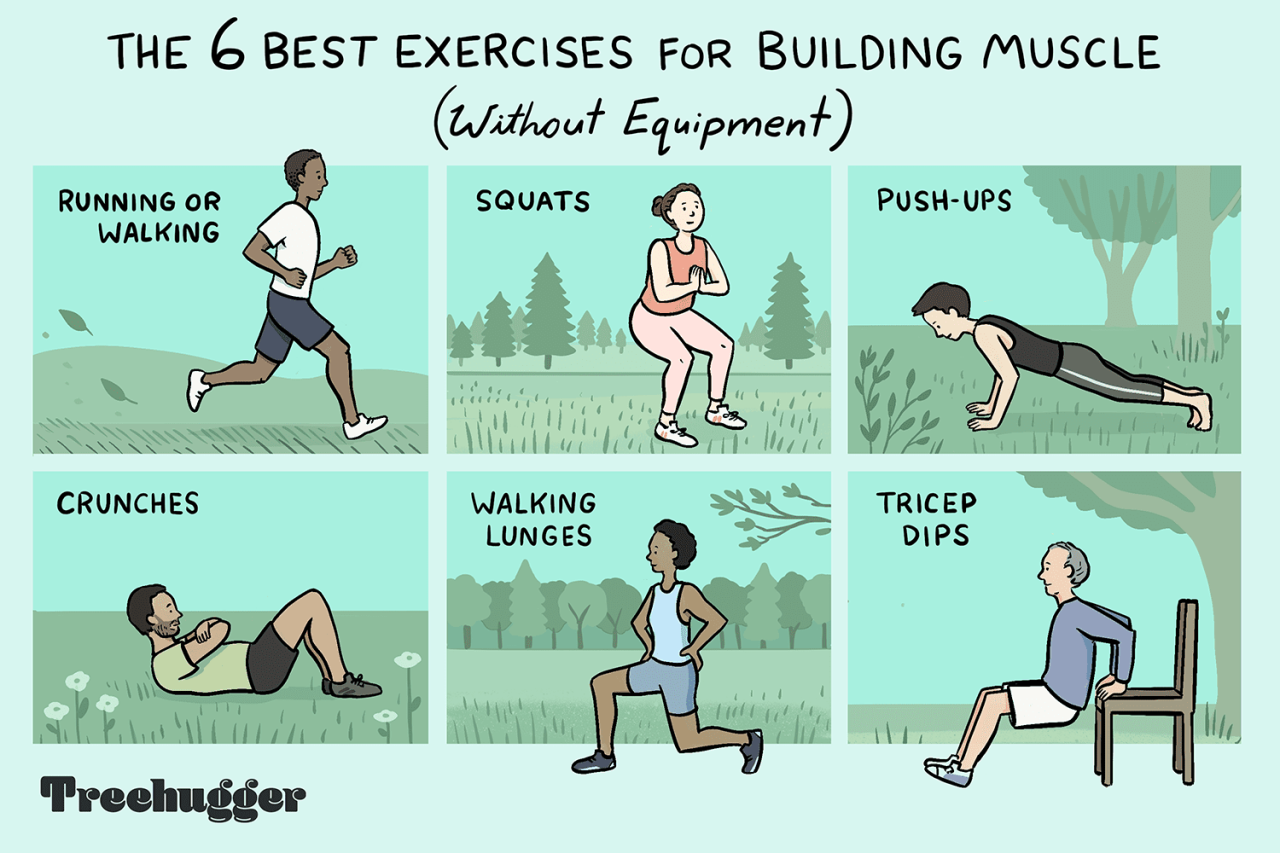Highly effective weightlifting exercises for building strength quickly? Sounds like a superhero origin story, doesn’t it? Forget waiting months for results – we’re talking about unlocking your inner Hulk (or She-Hulk!) in record time. But before you start picturing yourself bench-pressing a small car, let’s be realistic: genetics, experience, and a diet that wouldn’t make a squirrel blush all play a part.
This isn’t a magic spell; it’s a strategic plan to sculpt your physique and become a force of nature in the gym. Prepare for a journey into the land of iron, where sweat becomes your best friend and gains are the ultimate reward!
This guide dives deep into compound exercises – your ticket to overall strength – and isolation exercises, perfect for sculpting those individual muscle groups. We’ll explore different training splits, from full-body blasts to strategic upper/lower routines, helping you find the perfect workout schedule to fit your lifestyle (and avoid burnout). We’ll also unravel the mysteries of nutrition, recovery, and the often-overlooked art of proper form.
Get ready to transform your body and mind. Let’s get started!
Introduction

So, you want to get strong, and you want to get strong
quickly*. That’s admirable! But let’s be clear
“quickly” in the world of strength training isn’t measured in days, or even weeks, for most people. It’s a marathon, not a sprint, albeit a marathon you can hopefully finish feeling significantly stronger. Think of it like baking a cake – you can’t rush the process without compromising the final product. Similarly, building real, lasting strength takes time and dedication.Factors Influencing the Speed of Strength GainsSeveral factors significantly impact how rapidly you see improvements in strength.
It’s a complex interplay of genetics, training experience, and nutrition. Ignoring any of these elements is like trying to build a house on a shaky foundation – it might stand for a while, but it won’t last.
Genetic Predisposition
Genetics play a significant role in determining your potential for strength gains. Some individuals are naturally predisposed to build muscle and strength more easily than others. Think of it as a starting point on a race track – some runners begin closer to the finish line than others. This doesn’t mean those further back can’t win; it just means they might need to work a bit harder.
This is why comparing your progress to others is often unproductive. Focus on your own journey.
Training Experience
Your prior training experience is another crucial factor. A complete novice will likely see more rapid initial strength gains than someone who’s been lifting for years. This is because the nervous system adapts quickly in the beginning, leading to significant strength improvements even before significant muscle growth occurs. A seasoned lifter, on the other hand, will likely see more gradual increases as their body has already adapted to a certain level of stimulus.
Think of it like learning a new skill – you’ll improve rapidly at first, then the progress slows as you reach a higher skill level.
Nutrition
Finally, nutrition is paramount. You can’t build a strong body without providing it with the necessary building blocks. Sufficient protein intake is essential for muscle repair and growth, while adequate calorie consumption ensures you have the energy to train effectively. Neglecting nutrition is like trying to build a car without any parts – it’s simply not going to work.
A well-balanced diet, including enough protein, carbohydrates, and healthy fats, is vital for optimal strength gains.
Realistic Timeframe for Noticeable Strength Improvements, Highly effective weightlifting exercises for building strength quickly
While individual results vary, most individuals can expect to see noticeable strength improvements within 4-8 weeks of consistent, well-structured training. This doesn’t mean you’ll be bench-pressing your body weight overnight, but you should definitely notice improvements in your lifts and overall strength. For example, a beginner might see a significant increase in their squat or deadlift within this timeframe.
However, continued progress beyond this initial phase will likely be more gradual.
Strength Gains Versus Muscle Hypertrophy
It’s important to differentiate between strength gains and muscle hypertrophy (muscle growth). While they are often intertwined, they are distinct processes. Initially, much of your strength increase comes from neurological adaptations – your nervous system becomes more efficient at recruiting muscle fibers. Only later does muscle hypertrophy become a more significant contributor to strength gains. Think of it like learning to drive a car – initially, you’re focused on learning the mechanics and coordination, and only later do you refine your skills and become more efficient.
Compound Exercises for Maximal Strength Development

Let’s ditch the bicep curls and leg extensions for a moment (they have their place, don’t get me wrong, but we’re aiming forserious* strength gains here). Compound exercises are the heavy hitters of the weightlifting world – movements that work multiple muscle groups simultaneously, leading to greater overall strength and muscle growth. Think of them as the all-you-can-eat buffet of muscle building, rather than picking at a single appetizer.
They’re the key to unlocking your inner superhero (or at least, a significantly stronger you).
Effective Compound Exercises
The following table Artikels some of the most effective compound exercises for building maximal strength. Remember, proper form is paramount to avoid injury and maximize results. Think of your body as a finely tuned machine; treat it with respect and it will reward you handsomely.
| Exercise Name | Target Muscle Groups | Proper Form Description | Common Mistakes to Avoid |
|---|---|---|---|
| Squat | Quads, glutes, hamstrings, core | Stand with feet shoulder-width apart, toes slightly outward. Lower your hips as if sitting in a chair, keeping your back straight and chest up. Push through your heels to return to standing. | Rounding your back (leads to injury!), letting your knees cave inward, not going deep enough. |
| Deadlift | Hamstrings, glutes, back, traps | Stand with feet hip-width apart, shins close to the bar. Bend at your hips and knees, keeping your back straight. Grip the bar with an overhand or mixed grip. Lift the bar by extending your hips and knees simultaneously. | Rounding your back (again, a big no-no!), lifting with your back instead of your legs, not engaging your core. |
| Bench Press | Chest, shoulders, triceps | Lie on a bench with feet flat on the floor. Grip the bar slightly wider than shoulder-width apart. Lower the bar to your chest, keeping your elbows slightly bent. Push the bar back up to the starting position. | Arching your back excessively, bouncing the bar off your chest, not controlling the weight on the descent. |
| Overhead Press | Shoulders, triceps | Stand with feet shoulder-width apart, holding a barbell at shoulder height. Press the bar straight overhead, keeping your core engaged and your back straight. Lower the bar slowly back to the starting position. | Using momentum to lift the weight, arching your back, locking your elbows at the top. |
Warm-up Routines for Compound Lifts
A proper warm-up is crucial to prepare your body for the demands of compound lifts. Think of it as lubricating your engine before a long drive – it prevents breakdowns and ensures optimal performance. A good warm-up should include:
General warm-up (5-10 minutes): Light cardio, such as jogging or jumping jacks, to increase blood flow and raise your body temperature. Dynamic stretching, such as arm circles, leg swings, and torso twists, to improve range of motion and flexibility.
Specific warm-up (5-10 minutes): Perform lighter versions of the compound lift you’ll be doing. For example, before squats, do bodyweight squats or goblet squats. Before deadlifts, do Romanian deadlifts with lighter weight. This prepares your muscles and nervous system for the heavier weight you’ll be lifting.
Progressive Overload for Compound Exercises
Progressive overload is the cornerstone of strength training. It simply means consistently increasing the demands placed on your muscles over time. This could involve increasing the weight, reps, sets, or decreasing rest time. Without progressive overload, your body adapts to the current stimulus and plateaus. Think of it as constantly challenging your muscles to grow stronger; if you keep lifting the same weight, your body will eventually say, “Been there, done that, moving on.”
Examples of progressive overload:
Adding 2.5 lbs to the bar each week for squats.
Increasing the number of reps by 2-3 each week for bench press.
Adding an extra set to your deadlift routine every other week.
Reducing rest time between sets by 15 seconds.
These small, incremental increases, consistently applied, will lead to significant strength gains over time. Remember, consistency is key. Don’t try to jump to the next level too quickly; steady progress is more sustainable and less prone to injury.
Isolation Exercises for Targeted Muscle Growth: Highly Effective Weightlifting Exercises For Building Strength Quickly
So, you’ve been diligently smashing those compound lifts, building a solid foundation of strength. Fantastic! But now it’s time to sculpt those muscles, to really bring out the definition and add that extra touch of aesthetic appeal. Enter the world of isolation exercises – your secret weapon for targeted muscle growth. Think of compound lifts as laying the groundwork for a skyscraper; isolation exercises are the intricate detailing that makes it a masterpiece.Isolation exercises focus on one muscle group at a time, allowing for a more intense and controlled contraction.
This precision helps to maximize muscle hypertrophy (growth), leading to noticeable increases in size and definition. While compound lifts are crucial for overall strength, isolation exercises are your key to sculpting a truly impressive physique.
Sample Workout Routine Incorporating Isolation Exercises
This sample routine is designed to complement a compound lifting program. Remember to adjust the weight and reps based on your individual strength levels. Always prioritize proper form over lifting heavy weight. This routine focuses on a push/pull/legs split.
Day 1: Chest & Triceps
- Bench Press (Compound – warm-up)
- Cable Flyes (Isolation – 3 sets of 12-15 reps)
- Dumbbell Flyes (Isolation – 3 sets of 12-15 reps)
- Close-Grip Bench Press (Compound – warm-up)
- Overhead Dumbbell Extension (Isolation – 3 sets of 12-15 reps)
- Cable Pushdowns (Isolation – 3 sets of 12-15 reps)
Day 2: Back & Biceps
- Pull-ups (Compound – warm-up)
- Lat Pulldowns (Isolation – 3 sets of 12-15 reps)
- Seated Cable Rows (Isolation – 3 sets of 12-15 reps)
- Bicep Curls (Isolation – 3 sets of 12-15 reps)
- Hammer Curls (Isolation – 3 sets of 12-15 reps)
- Concentration Curls (Isolation – 3 sets of 12-15 reps)
Day 3: Legs & Shoulders
- Squats (Compound – warm-up)
- Leg Extensions (Isolation – 3 sets of 12-15 reps)
- Hamstring Curls (Isolation – 3 sets of 12-15 reps)
- Calf Raises (Isolation – 3 sets of 15-20 reps)
- Overhead Press (Compound – warm-up)
- Lateral Raises (Isolation – 3 sets of 12-15 reps)
- Front Raises (Isolation – 3 sets of 12-15 reps)
Machines Versus Free Weights for Isolation Exercises
The age-old debate! Both machines and free weights offer unique advantages for isolation exercises. Machines provide stability and are generally easier to learn, making them ideal for beginners or those focusing on specific muscle groups without the risk of injury from improper form. Think of them as training wheels for your muscles.Free weights, on the other hand, require more balance and coordination, engaging stabilizer muscles and leading to greater functional strength.
They also allow for a greater range of motion, potentially leading to more muscle activation. Consider free weights as the advanced level, pushing your body and muscles to work harder and smarter. The best choice often depends on your experience level, goals, and personal preference.
Isolation Exercises by Muscle Group
Choosing the right isolation exercises is key to maximizing your gains. Here’s a breakdown by muscle group:
Chest: Cable Flyes, Dumbbell Flyes, Pec Deck Flyes
Back: Lat Pulldowns, Seated Cable Rows, Face Pulls
Legs: Leg Extensions, Hamstring Curls, Leg Press, Calf Raises
Shoulders: Lateral Raises, Front Raises, Reverse Flyes
Arms: Bicep Curls (various types), Triceps Pushdowns (various types), Overhead Triceps Extensions
Training Split Strategies for Optimal Results
Choosing the right training split is like picking the perfect pair of lifting shoes – get it wrong, and you’ll be limping (metaphorically, of course, unless you actually trip over your own feet). The ideal split depends on your goals, experience level, and recovery capacity. Different splits offer unique advantages and disadvantages, so let’s dive into the nitty-gritty.Different training splits cater to various needs and experience levels.
The frequency and intensity of workouts directly impact muscle growth and strength development, so selecting the right approach is crucial for optimizing results and avoiding injury.
Full Body Training Splits
Full body workouts, where you hit every major muscle group in each session, are fantastic for beginners. They promote overall strength gains and are time-efficient. However, the high training volume can lead to overtraining if not managed carefully, limiting the intensity you can apply to each muscle group. A full-body routine might involve 3 sessions a week, allowing ample recovery between each.
This approach is less ideal for advanced lifters who need more specialized training to target specific muscle groups more effectively.
Upper/Lower Body Splits
This split, as the name suggests, divides your workouts into upper and lower body days. This allows for more focused training volume on each body part, leading to greater hypertrophy and strength gains. You can train more frequently (e.g., 4 days a week) with adequate rest between sessions targeting the same muscle groups. However, the downside is that it requires more time commitment compared to full body routines.
Push/Pull/Legs Splits
This split categorizes exercises based on the movement pattern: pushing (chest, shoulders, triceps), pulling (back, biceps), and legs. This allows for even more specialized training and allows for higher training frequency. However, this split demands excellent planning and a deep understanding of exercise selection to ensure all muscle groups are adequately worked. Overtraining is a real risk if not managed properly.
It’s not recommended for absolute beginners.
Sample 4-Day Upper/Lower Split Workout Routine
This routine focuses on compound exercises for maximal strength development and incorporates some isolation exercises for targeted muscle growth. Remember to adjust the weight based on your capabilities and always prioritize proper form over lifting heavier weight.
| Day | Focus | Exercises | Sets | Reps |
|---|---|---|---|---|
| Monday (Upper) | Chest & Shoulders | Bench Press, Overhead Press, Incline Dumbbell Press, Lateral Raises | 3-4 | 6-12 |
| Tuesday (Lower) | Legs & Core | Squats, Deadlifts, Romanian Deadlifts, Leg Press, Plank | 3-4 | 6-12 |
| Wednesday (Rest) | Active Recovery (light cardio, stretching) | |||
| Thursday (Upper) | Back & Biceps | Pull-ups, Barbell Rows, Bicep Curls, Hammer Curls | 3-4 | 6-12 |
| Friday (Lower) | Legs & Calves | Lunges, Leg Extensions, Hamstring Curls, Calf Raises | 3-4 | 6-12 |
| Saturday & Sunday (Rest) | Complete Rest |
Overtraining Prevention Strategies
Overtraining is a real beast that can derail your progress and even lead to injury. Signs include persistent fatigue, decreased performance, mood swings, and increased susceptibility to illness. Prevention involves strategic planning and self-awareness. This includes adequate rest, proper nutrition, and listening to your body. Prioritizing sleep (7-9 hours per night), incorporating active recovery days, and avoiding excessive training volume are key strategies.
Remember, consistency over intensity; slow and steady wins the race (and builds muscle!).
Nutritional Considerations for Strength Gains

Fueling your body for serious strength gains isn’t about just eating; it’s about strategic nourishment. Think of your muscles as high-performance engines – they need the right type and amount of fuel to perform optimally and recover effectively. Ignoring this crucial aspect is like trying to win a race in a car running on rusty cogs and flat tires.
Let’s get you properly fueled.Macronutrient Balance: The Trifecta of Muscle GrowthThe key to maximizing muscle growth and recovery lies in finding the sweet spot of macronutrient balance: protein, carbohydrates, and fats. Each plays a vital role, and neglecting one will hinder your progress. Imagine a three-legged stool – if one leg is weak, the whole thing collapses.
Protein Intake for Muscle Synthesis
Protein is the undisputed king of muscle building. It provides the amino acids your body needs to repair and build muscle tissue after intense weightlifting sessions. Aim for a daily protein intake of 1.6-2.2 grams per kilogram of body weight. For a 70kg individual, this translates to 112-154 grams of protein daily. Sources include lean meats (chicken, turkey, fish), eggs, dairy products (Greek yogurt, cottage cheese), legumes, and protein powders.
Want to build serious strength, like, Hercules-level strength? Then ditch the wimpy workouts! Highly effective weightlifting exercises for building strength quickly involve compound movements that target multiple muscle groups. To really dial in your routine, check out this awesome resource on muscular strength exercises for some serious inspiration. After you’ve boosted your knowledge, get back to those barbells – remember, gains don’t happen by accident!
Think of protein as the bricks and mortar of your muscle construction project.
Carbohydrate Consumption for Energy and Recovery
Carbohydrates are your body’s primary energy source, especially during intense workouts. They replenish glycogen stores (your muscles’ energy reserves) depleted during training. Adequate carbohydrate intake fuels your workouts, preventing fatigue and allowing you to lift heavier weights with better form. Good sources include whole grains (brown rice, quinoa, oats), fruits, and vegetables. Consider carbs the fuel that powers your muscle-building engine.
Fat Intake for Hormone Production and Overall Health
Don’t shy away from healthy fats! They’re essential for hormone production, nutrient absorption, and overall health. Healthy fats also contribute to satiety, keeping you feeling full and satisfied between meals. Incorporate sources like avocados, nuts, seeds, and olive oil into your diet. Think of fats as the lubricating oil keeping your entire system running smoothly.
Sample Meal Plan
This is a sample plan and needs to be adjusted based on individual needs and caloric goals.Pre-Workout Meal (1-2 hours before): Oatmeal with berries and a scoop of whey protein. This provides sustained energy and readily available amino acids.Post-Workout Meal (within 30-60 minutes): Grilled chicken breast with brown rice and steamed broccoli. This combination provides protein for muscle repair and carbohydrates to replenish glycogen stores.Throughout the Day: Examples include Greek yogurt with fruit, a handful of almonds, a tuna salad sandwich on whole-wheat bread, or a lean protein shake.
The key is to spread your protein and carbohydrate intake evenly throughout the day.
Hydration: The Often-Overlooked Essential
Water is not just a beverage; it’s a crucial component of countless bodily functions, including muscle function and recovery. Dehydration can significantly impair your strength, endurance, and overall performance. Aim to drink plenty of water throughout the day, especially before, during, and after your workouts. Think of water as the lifeblood of your entire system – without it, nothing functions properly.
A good rule of thumb is to drink half your body weight in ounces of water daily.
Recovery and Rest
Think of your muscles as temperamental rock stars: they need the right fuel, the right training, and crucially, the right amount of downtime to unleash their full potential. Ignoring recovery is like expecting a band to play a sold-out stadium show every night without ever sleeping – it’s a recipe for burnout and subpar performances (or, in our case, subpar gains).
This section delves into the often-overlooked but undeniably vital world of recovery and rest for maximizing your strength gains.Sleep, stress management, and active recovery are the unsung heroes of strength building. Sufficient sleep allows your body to repair muscle tissue, synthesize protein, and regulate hormones crucial for growth. Stress, on the other hand, can wreak havoc on your recovery process by releasing cortisol, a hormone that can impede muscle growth and increase inflammation.
Active recovery, incorporating light exercise and stretching, enhances blood flow, reduces muscle soreness, and promotes faster recovery.
Sleep Optimization for Strength Gains
Prioritizing sleep is not just about feeling rested; it’s about optimizing your body’s natural repair mechanisms. Aim for 7-9 hours of quality sleep per night. Establishing a consistent sleep schedule, creating a relaxing bedtime routine (think warm bath, calming music, reading a book), and ensuring your bedroom is dark, quiet, and cool can significantly improve sleep quality. Consider using a sleep tracker to monitor your sleep patterns and identify areas for improvement.
For example, consistently getting only 5 hours of sleep can lead to decreased testosterone levels, which are crucial for muscle growth and strength gains.
Stress Management Techniques for Enhanced Recovery
Stress is a silent saboteur of strength gains. Chronic stress elevates cortisol levels, hindering muscle protein synthesis and increasing the risk of injury. Effective stress management techniques include mindfulness meditation, deep breathing exercises, yoga, and spending time in nature. Learning to say “no” to commitments that overwhelm you is also crucial. For instance, consistently feeling stressed due to work deadlines can lead to increased muscle soreness and slower recovery times, directly impacting training performance.
Active Recovery Methods: Light Cardio, Stretching, and Foam Rolling
Active recovery isn’t about hitting the gym with the same intensity as your regular workouts. It’s about gently stimulating blood flow and reducing muscle stiffness. Incorporate light cardio activities like walking, cycling, or swimming for 20-30 minutes on your rest days. Stretching improves flexibility and range of motion, preventing muscle tightness and injuries. Foam rolling can help release muscle tension and improve tissue repair.
For example, a 20-minute walk after a leg day can significantly reduce muscle soreness and improve blood circulation, leading to faster recovery and reduced risk of injury. A routine incorporating these three elements, perhaps on off days, can significantly aid recovery and enhance training performance.
Illustrative Examples of Effective Exercises

Let’s ditch the theory and dive headfirst into the glorious world of actually
doing* these exercises. We’ll focus on three powerhouses
the barbell back squat, the bench press, and the deadlift. Get ready to feel the burn (in a good way, of course!).
Barbell Back Squat
The barbell back squat is the king of lower body exercises, a true test of strength and a fantastic builder of leg and core muscle. Imagine a throne of iron – that’s your barbell. Position it across your upper back, resting on your traps (those muscles at the back of your neck and shoulders). Your feet should be shoulder-width apart, toes slightly pointed outwards.
Unrack the bar, taking a controlled step back. Maintaining a straight back (think proud posture!), lower yourself by bending at the knees and hips until your thighs are parallel to the ground, or slightly below. Your heels should remain firmly planted. Pause briefly at the bottom, then explosively drive back up to the starting position, squeezing your glutes at the top.
Key muscle activation includes quads, glutes, hamstrings, and core. Remember to breathe! Inhale as you descend, exhale as you ascend. Improper form can lead to injury, so start with lighter weights and focus on technique before increasing the load.
Bench Press
Next up, the bench press – the ultimate upper body strength builder. Lie on a bench with your feet flat on the floor. Grip the barbell slightly wider than shoulder-width apart, with your hands in a pronated grip (palms facing away from you). Unrack the bar, maintaining a stable and controlled position. Lower the bar slowly to your chest, touching it lightly.
Pause briefly, then powerfully push the bar back up to the starting position, fully extending your arms. The bench press primarily works your pectorals (chest muscles), triceps (back of your upper arms), and anterior deltoids (front of your shoulders). Keep your elbows slightly tucked in and avoid bouncing the bar off your chest. Focus on a controlled movement throughout the entire range of motion.
As with the squat, proper form is paramount to avoid injury.
Deadlift
Finally, the mighty deadlift – a full-body exercise that challenges nearly every muscle in your body. Stand with your feet hip-width apart, centered over the barbell. Bend down and grip the bar with an overhand grip (palms facing down), slightly wider than shoulder-width apart. Your shins should be close to the bar. Keeping your back straight (think of a plank!), engage your core and drive through your heels to lift the bar.
Maintain a neutral spine throughout the lift. The bar should stay close to your body as you lift. At the top, your back should be straight, not arched. Slowly lower the bar back to the ground, reversing the movement. The deadlift activates muscles throughout your entire body, including your back, hamstrings, glutes, quads, and forearms.
Focus on maintaining a tight core and avoid rounding your back at any point. This is another exercise where proper form is absolutely crucial to avoid injury.
Last Point
So, you’ve journeyed through the world of rapid strength building, armed with knowledge of compound and isolation exercises, strategic training splits, and a newfound respect for proper nutrition and recovery. Remember, building strength quickly isn’t about sacrificing form for speed; it’s about smart training and consistent effort. Listen to your body, celebrate your wins (even the small ones!), and remember that the journey is just as rewarding as the destination.
Now go forth and conquer those weights! You’ve got this!
